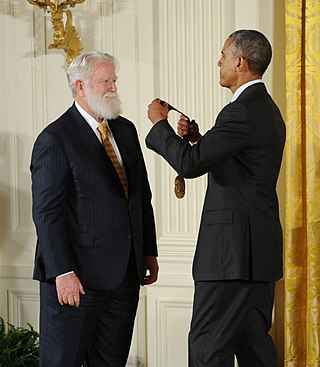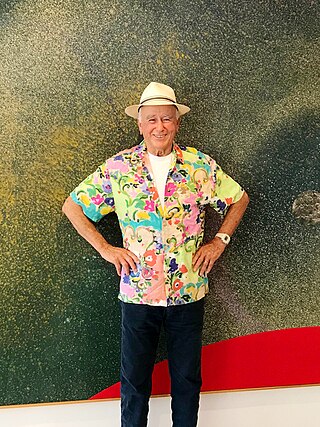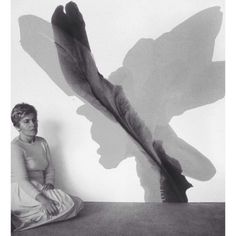
Robert Walter Irwin was an American installation artist who explored perception and the conditional in art, often through site-specific, architectural interventions that alter the physical, sensory and temporal experience of space.

Jay DeFeo was an American visual artist who became celebrated in the 1950s as part of the spirited community of Beat artists, musicians, and poets in San Francisco. Best known for her monumental work The Rose, DeFeo produced courageously experimental works throughout her career, exhibiting what art critic Kenneth Baker called “fearlessness.”

James Turrell is an American artist known for his work within the Light and Space movement. He is considered the "master of light" often creating art installations that mix natural light with artificial color through openings in ceilings thereby transforming internal spaces by ever shifting and changing color.

Anne Truitt, born Anne Dean, was an American sculptor of the mid-20th century.
Joe Goode, is an American visual artist, known for his pop art paintings. Goode made a name for himself in Los Angeles, California, through his cloud imagery and milk bottle paintings which were associated with the Pop Art movement. The artist is also closely associated with Light and Space, a West Coast art movement of the early 1960s. He resides in Los Angeles, California.

Billy Al Bengston was an American visual artist and sculptor who lived and worked in Venice, California, and Honolulu, Hawaii. Bengston was probably best known for work he created that reflected California's "Kustom" car and motorcycle culture. He pioneered the use of sprayed layers of automobile lacquer in fine art and often used colors that were psychedelic and shapes that were mandala-like. ARTnews referred to Bengston as a "giant of Los Angeles's postwar art scene."

Liza Ryan is an American contemporary artist living in Los Angeles, CA. Her work is held in the collections of the J. Paul Getty Museum, Los Angeles County Museum of Art among others.
Sylvia Snowden is an African American abstract painter who works with acrylics, oil pastels, and mixed media to create textured works that convey the "feel of paint". Many museums have hosted her art in exhibits, while several have added her works to their permanent collections.

Linda Vallejo is an American artist known for painting, sculpture and ceramics. Her work often addresses her Mexican-American ethnic identity within the context of American art and popular culture. The founder of the commercial art gallery Galería Las Américas, she is also an arts educator and has been involved intraditional Native American and Mexican rituals and ceremonies for many years.

Light and Space denotes a loosely affiliated art movement related to op art, minimalism and geometric abstraction originating in Southern California in the 1960s and influenced by John McLaughlin. It is characterized by a focus on perceptual phenomena, such as light, volume and scale, and the use of materials such as glass, neon, fluorescent lights, resin and cast acrylic, often forming installations conditioned by the work's surroundings. Whether by directing the flow of natural light, embedding artificial light within objects or architecture, or by playing with light through the use of transparent, translucent or reflective materials, Light and Space artists make the spectator's experience of light and other sensory phenomena under specific conditions the focus of their work. From the movement's inception, artists were incorporating into their work the latest technologies of the Southern California-based engineering and aerospace industries to develop sensuous, light-filled objects. Turrell, who has spread the movement worldwide, summed up its philosophy in saying, "We eat light, drink it in through our skins."
Helen Pashgian is an American visual artist who lives and works in Pasadena, California. She is a primary member of the Light and Space art movement of the 1960s, but her role has been historically under-recognized.

Jennie C. Jones is an African-American artist living and working in Brooklyn, New York. Her work has been described, by Ken Johnson, as evoking minimalism, and paying tribute to the cross-pollination of different genres of music, especially jazz. As an artist, she connects most of her work between art and sound. Such connections are made with multiple mediums, from paintings to sculptures and paper to audio collages. In 2012, Jones was the recipient of the Joyce Alexander Wien Prize, one of the biggest awards given to an individual artist in the United States. The prize honors one African-American artist who has proven their commitment to innovation and creativity, with an award of 50,000 dollars. In December 2015 a 10-year survey of Jones's work, titled Compilation, opened at the Contemporary Arts Museum in Houston, Texas.
Nina Chanel Abney is an American artist, based in New York. She was born in Harvey, Illinois. She is an African American contemporary artist and painter who explores race, gender, pop culture, homophobia, and politics in her work.
Mary Weatherford is a Los Angeles–based painter. She is known for her large paintings incorporating neon lighting tubes. Her work is featured in museums and galleries including the Hirshhorn Museum and Sculpture Garden, Brooklyn Museum, Museum of Modern Art, and the High Museum of Art. Weatherford's solo exhibitions include Mary Weatherford: From the Mountain to the Sea at Claremont McKenna College, I've Seen Gray Whales Go By at Gagosian West, and Like The Land Loves the Sea at David Kordansky Gallery, Los Angeles. Her work has been part of group exhibitions at the Museum of Modern Art and the Rose Art Museum at Brandeis University.

Suzanne Jackson is an American visual artist, gallery owner, poet, dancer, educator, and set designer; with a career spanning five decades. Her work has been exhibited in museums and galleries around the world. Since the late 1960s, Jackson has dedicated her life to studio art with additional participation in theatre, teaching, arts administration, community life, and social activism. Jackson's oeuvre includes poetry, dance, theater, costume design, paintings, prints, and drawings.

Norman Charles Zammitt was an American artist in Southern California who was at the leading edge of the Light and Space Movement, pioneering with his transparent sculptures in the early 1960s, followed in the 1970s by his large scale luminous color paintings.

Irene Monat Stern (1932-2010) was a Poland-born American artist who spent her working life in the United States. Known for her abstract paintings, her works have been displayed and collected across the United States; from The Esther-Robles Gallery in Los Angeles, to the Metropolitan Museum of Art in New York, to the Hirshhorn Museum and Sculpture Garden in Washington D.C.'s permanent collection.
Mary Obering was an American painter focusing mainly on geometric abstraction.
Kayne Griffin is a contemporary art gallery based in Los Angeles. The gallery represents and works with artists such as James Turrell, Mary Corse, David Lynch, Tomoharu Murakami, Peter Shire, Rosha Yaghmai, Jiro Takamatsu, Anthony Hernandez, Mika Tajima, Mary Obering, Liza Ryan, Hank Willis Thomas, Llyn Foulkes and Beverly Pepper.
Alex Olson is an American artist based in Los Angeles, CA. Olson is known for her use of impasto paint and visual patterning.












